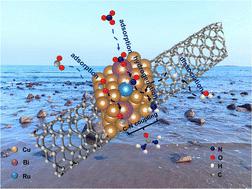当前位置:
X-MOL 学术
›
Energy Environ. Sci.
›
论文详情
Our official English website, www.x-mol.net, welcomes your feedback! (Note: you will need to create a separate account there.)
Achieving efficient urea electrosynthesis through improving the coverage of a crucial intermediate across a broad range of nitrate concentrations
Energy & Environmental Science ( IF 32.4 ) Pub Date : 2024-06-11 , DOI: 10.1039/d4ee01878h Yaodong Yu 1 , Yuyao Sun 1 , Jiani Han 1, 2 , Yujia Guan 1 , Hongdong Li 1 , Lei Wang 1 , Jianping Lai 1
Energy & Environmental Science ( IF 32.4 ) Pub Date : 2024-06-11 , DOI: 10.1039/d4ee01878h Yaodong Yu 1 , Yuyao Sun 1 , Jiani Han 1, 2 , Yujia Guan 1 , Hongdong Li 1 , Lei Wang 1 , Jianping Lai 1
Affiliation

|
The electrocatalytic synthesis of urea by coupling of nitrate ions as a wastewater pollutant with CO2 is a sustainable pathway. However, efficient electrosynthesis of urea across a broad range of nitrate concentrations has not been reported. Here, a series of Ru-doped CuxBi/CNT multisite catalysts for urea electrosynthesis are designed to benefit from triple synergistic modulation and exhibit excellent performance. The composition and ratio optimised Ru–Cu9Bi/CNT catalyst achieves urea yields greater than 40.0 mmol h−1 g−1 over a wide range of nitrate concentrations (10–1000 mM) at −0.4 V vs. RHE. Notably, the highest FE value of 75.6% to date was achieved in 1 M nitrate solution. Comprehensive analysises show that the Cu and Bi sites activate CO2 and NO3−, respectively. In addition, doped Ru promotes water dissociation to form *H. In the key step of electrocatalytic urea synthesis, the strong adsorption of *H by doped Ru inhibits the hydrogen evolution reaction (HER). The acceleration of NO3− reduction by Bi synergises with the modulation of *H adsorption energy by Ru to improve the coverage of the key intermediate *NHO at different NO3− concentrations, ensuring the subsequent electrosynthesis of urea.
中文翻译:

通过提高关键中间体在广泛硝酸盐浓度范围内的覆盖率,实现高效的尿素电合成
通过废水污染物硝酸根离子与 CO 2 的耦合电催化合成尿素是一种可持续的途径。然而,在广泛的硝酸盐浓度范围内有效电合成尿素尚未见报道。在此,设计了一系列用于尿素电合成的Ru掺杂Cu x Bi/CNT多位点催化剂,受益于三重协同调节并表现出优异的性能。成分和比例优化的 Ru-Cu 9 Bi/CNT 催化剂可在较宽的硝酸盐浓度范围内实现大于 40.0 mmol h −1 g −1 的尿素产量( 10–1000 mM),相对于 RHE,-0.4 V。值得注意的是,迄今为止 75.6% 的最高 FE 值是在 1 M 硝酸盐溶液中实现的。综合分析表明,Cu位点和Bi位点分别激活CO 2 和NO 3 − 。此外,掺杂的Ru促进水解离形成*H。在电催化尿素合成的关键步骤中,掺杂Ru对*H的强烈吸附抑制了析氢反应(HER)。 Bi加速NO 3 − 还原与Ru调节*H吸附能协同作用,提高了关键中间体*NHO在不同NO 3 浓度,保证后续尿素的电合成。
更新日期:2024-06-11
中文翻译:

通过提高关键中间体在广泛硝酸盐浓度范围内的覆盖率,实现高效的尿素电合成
通过废水污染物硝酸根离子与 CO 2 的耦合电催化合成尿素是一种可持续的途径。然而,在广泛的硝酸盐浓度范围内有效电合成尿素尚未见报道。在此,设计了一系列用于尿素电合成的Ru掺杂Cu x Bi/CNT多位点催化剂,受益于三重协同调节并表现出优异的性能。成分和比例优化的 Ru-Cu 9 Bi/CNT 催化剂可在较宽的硝酸盐浓度范围内实现大于 40.0 mmol h −1 g −1 的尿素产量( 10–1000 mM),相对于 RHE,-0.4 V。值得注意的是,迄今为止 75.6% 的最高 FE 值是在 1 M 硝酸盐溶液中实现的。综合分析表明,Cu位点和Bi位点分别激活CO 2 和NO 3 − 。此外,掺杂的Ru促进水解离形成*H。在电催化尿素合成的关键步骤中,掺杂Ru对*H的强烈吸附抑制了析氢反应(HER)。 Bi加速NO 3 − 还原与Ru调节*H吸附能协同作用,提高了关键中间体*NHO在不同NO 3 浓度,保证后续尿素的电合成。






































 京公网安备 11010802027423号
京公网安备 11010802027423号